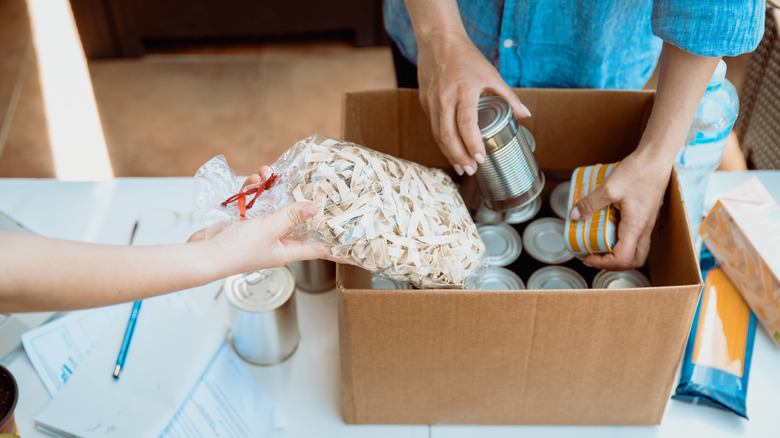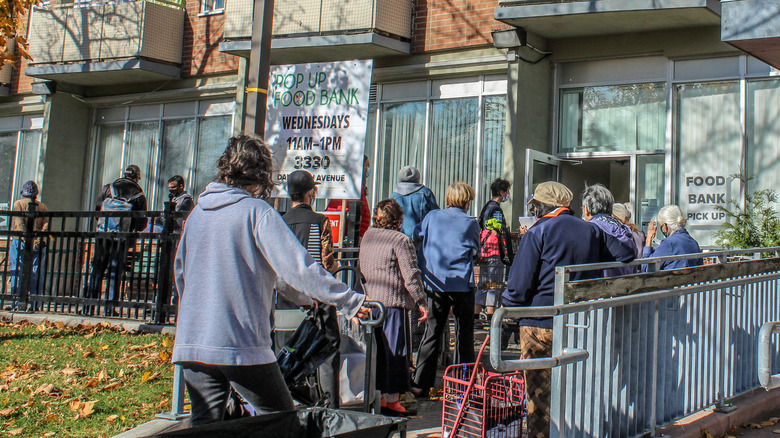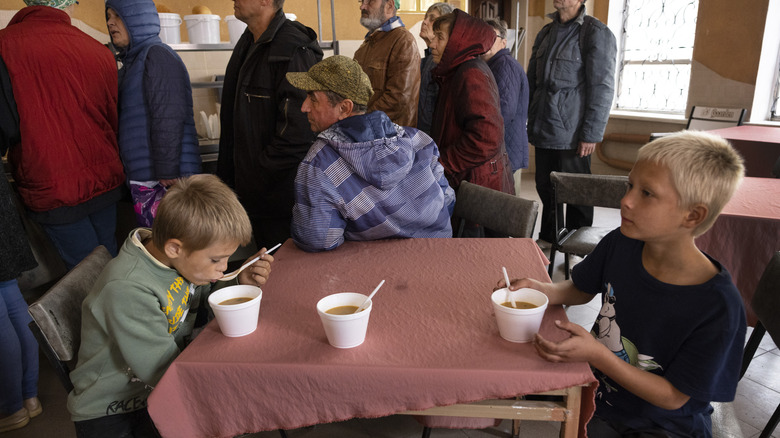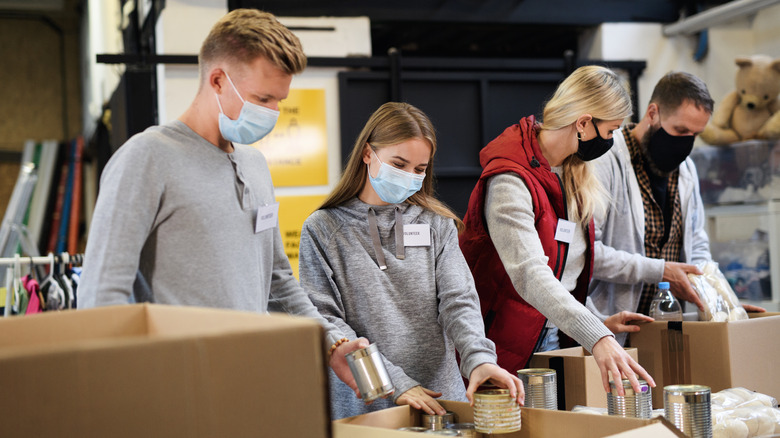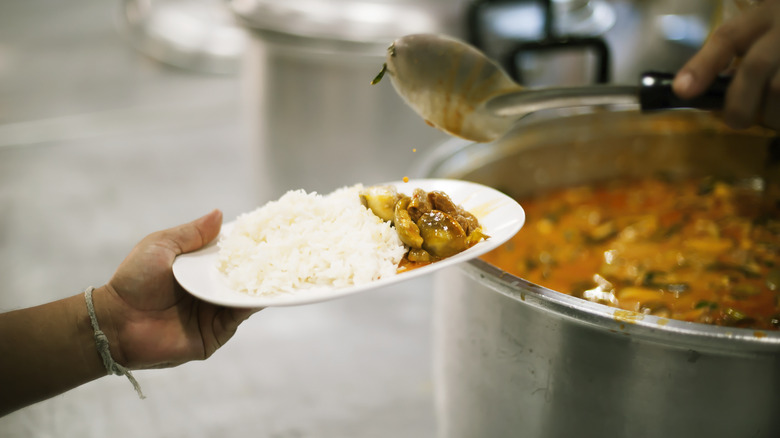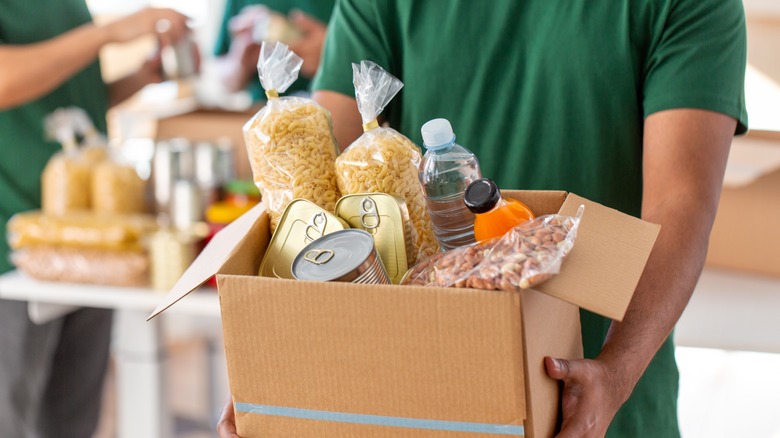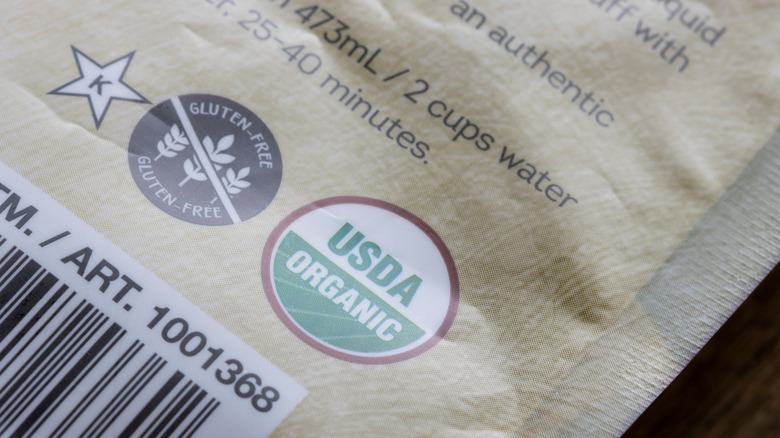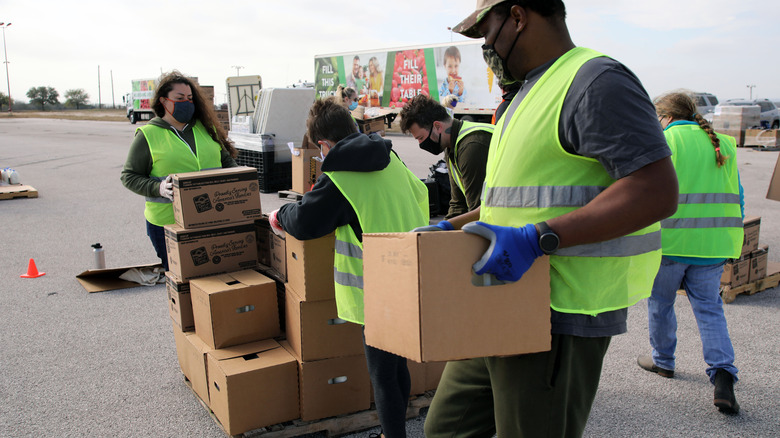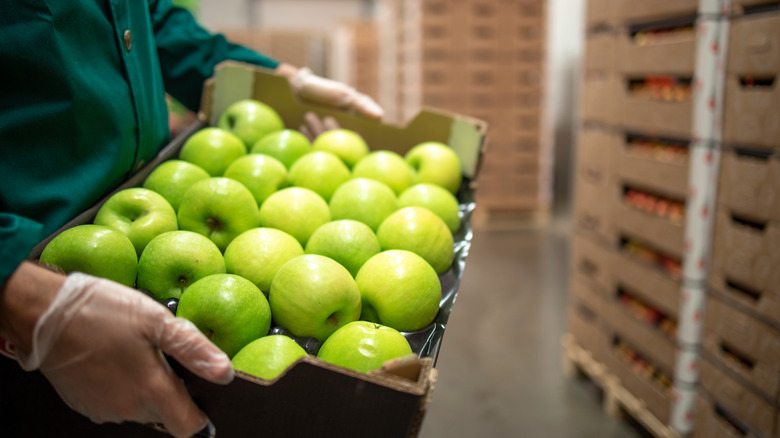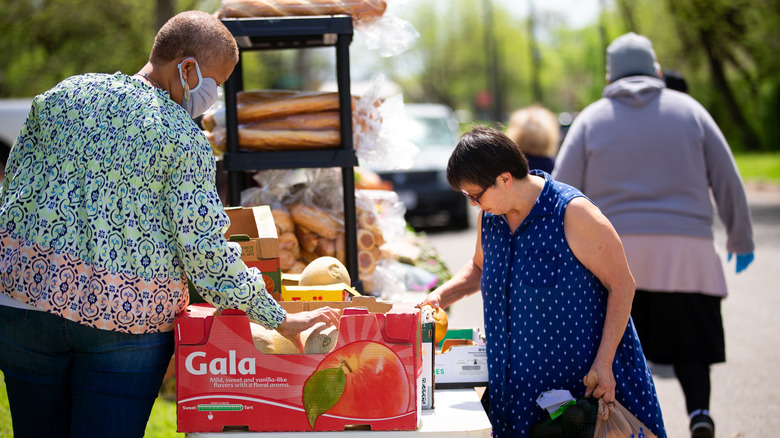12 Best Ways To Support Your Local Food Bank During The Holidays
As the holidays approach, it's natural to get excited about cozy socks, gift-giving, Thanksgiving recipe favorites, hot drinks, and, of course, all of the delicious delicacies that seem to always be in arms reach. While it's easy to get caught up in the excitement, festivities, and family drama, it's an especially important time of year to think beyond our own needs. Those without family support systems, steady incomes, and consistent safe shelter are at high risk for food insecurity. Local food banks are a wonderful resource for those in need, but they rely on support from their community to function.
If you've felt discouraged from getting involved in the past because of a lack of time or resources, it's important to understand that there are endless ways to help. Leslie Gordon, president and CEO of Food Bank for New York City, offers suggestions on the best ways to support your local food bank. There's no better time to make a difference, and with a little bit of compassion and motivation, you could be the one to help support a food-insecure family this holiday season.
Support your community
A strong community means a better life for everyone. Not only will your support directly benefit those in need, but community service work is associated with improved mental health for those volunteering. Per Western Connecticut State University, the benefits can range anywhere from advancing your career to encouraging new relationships through socialization. In fact, those skills learned through volunteer work can elevate your resume and round out your work experience. In addition, prioritizing helping those around you give you feelings of accomplishment and confidence. Those who volunteer weekly are likely to be happier, based on a study by Harvard University. It's not hard to find a friendly face among a group of volunteers!
For those who aren't able to donate their time but can donate items or money, the benefits are just as potent. A Utah State University study found that those who gave money away experienced happier moods. Sounds like a win-win situation, whether you're donating money, time, or anything in between.
Jump right in
With inflation at a high, and people still recovering from pandemic-related job loss, there are more food-insecure families now than ever. Since 2021, New York's network of over 400 soup kitchens and food pantries has seen a steep increase of 93% in new visitors, per Food Bank for NYC. According to the USDA, food pantry usage amongst food-insecure households increased significantly since 2020. Lines are lengthy, and stomachs are empty as America struggles with inflated rent, gas, groceries, and, of course, soaring unemployment.
If you're new to volunteer work or donating, this is the time to get involved! According to Leslie Gordon, In New York City alone there are nearly 1.6 million food-insecure individuals, and even before the pandemic, more than one in three households was having trouble covering their basic needs. Since then, situations have only declined. In 2021, the Food Bank for New York City distributed over 121 million meals across five boroughs, which was a historical high.
Understand your organizations
Food banks, food pantries, soup kitchens, donation centers... what's the difference? If you're new to the volunteer game, this may feel overwhelming. Each organization has its own purpose, but they work together to make sure that food is received by those who need it.
Food that has been donated from grocery stores, restaurants, farms, and individuals is stored at a food bank. This is where the food is kept and sorted for distribution, per Feeding America. From there, the food is transported to food pantries and soup kitchens in the area.
Food pantries distribute the food to individuals who are food insecure, and sometimes have pick-up locations in schools, hospitals, and other accessible public locations. Some pantries even offer delivery services for disabled and elderly folks. On the other hand, soup kitchens prepare ready-to-eat meals and serve them in-house to those in need. Often set up like a cafeteria, these programs are especially important for homeless individuals who don't have the means to cook or safely store ready-made food. This program gives them a chance to be served with dignity and enjoy a hot meal in a safe sheltered environment.
Donate your time
Have you noticed your grocery bill increasing with each visit? What about your gas and electric bills? Even if you're not food insecure, you may feel financially strapped and wary of making monetary donations. Luckily, there are plenty of ways you can help your community without writing a check. After all, one of the most valuable assets in life is time. According to the Capital Area Food Bank, volunteers are the most valuable resource and save the food bank millions of dollars annually.
Individuals can donate their time to food banks, food pantries, and soup kitchens. Volunteerism nearly doubles around the holiday season, so it's important to call the organization ahead of time or stop by to talk scheduling. If you have any particular skills in relation to the kind of work you'll be doing, or plan to be a consistent volunteer, be sure to let your organizer know.
At the Food Bank for New York City, Leslie Gordon offers volunteers a, "plethora of exciting opportunities, from distributing food and packing bags of fresh produce to helping with corporate events." All are welcome to these events, including families, groups, and companies, and Gordon encourages parents to bring along their little ones for a learning opportunity.
Whether you're sorting donations in the back or serving hot meals to those in need, every minute counts towards improving your life and the lives of those around you.
Cook a meal
As a reader of TastingTable, it's clear that you have an interest in the culinary arts. Whether you're a baker, creative cook, or avid recipe follower, sharing your creations with those in need is a great way to put your skills to use.
We can all agree, there's nothing better than home-cooked comfort meals. Unfortunately, this is not always an option for those with limited time and resources. For some children, the only hot meal they can rely on is provided by their school cafeteria, per the School Nutrition Association.
While some larger organizations like food banks and many food pantries may not accept home-cooked donations, some shelters will. Many allow visitors to bring a freshly prepared, home-cooked meal to be enjoyed side-by-side with the residents. Because of safety protocol, it's important to call ahead and inquire about the parameters of your local pantry or shelter before firing up the stove.
Donate non-perishables
If you've made donations before, you may be aware that most organizations encourage non-perishable items, such as canned foods to stock the pantries, freeze-dried meals, and shelf-stable products. This makes storage and distribution easier for organizations, as they won't need to rely on frequent temperature checks and refrigerated transportation and storage. In addition, this makes life easier for the consumer, because they don't have to rely on access to refrigeration and can store and save the food as necessary, per Feeding America.
Food items like canned and dried beans, pasta, canned vegetables, powdered milk, freeze-dried meals, uncooked grains, and shelf-stable soups are always safe options. Try to include as many canned fruits and vegetables as possible to ensure you are donating nutrient-dense options, as suggested by the Food Bank Of New York. If you'd like to include fresh produce with your donation, consider items that don't rely on refrigeration and have a long shelf life like onions, potatoes, winter squash, garlic, and root vegetables. If you're still unsure, call your local food bank and ask which foods they are in need of. They may suggest an item you may not think of, like baby formula, per Leslie Gordon. Food to never donate to a food bank includes expired or opened goods.
If you don't have food to spare, consider organizing a food drive through your work or school. Encourage those around you to donate non-perishables, and then bring them down to your local food bank for donation.
Be culturally sensitive
Around the holidays, it's important that people have access to culturally relevant foods, such as Halal, Kosher, vegetarian, et cetera, so that they can properly observe and celebrate their religious holiday with comfort. Both religion and culture are nonnegotiable parts of many people's lives, so customs shouldn't be overlooked when it comes to mealtime, especially around the holidays. Leslie Gordon stresses the importance of donating foods that reflect the communities they serve, and for a city as diverse as New York City, it's especially relevant to consider. She states that the diverse donates ensure "that all people are treated with the respect and dignity they deserve. Food is more than just energy — it reminds people of who they are and where they come from."
Even if you don't follow any dietary customs yourself, consider variety when donating food to a bank or pantry. Look for symbols like the Kosher "K", or vegan "V" on the packaging. Go out of your way to buy holiday-specific and culturally diverse foods like canned vegetable curries, matzoh ball soup, stuffing mix, and dried plantains.
Be sure to check for openings in the packaging, and expiration dates. Banks and pantries will not accept expired or opened food items.
Use your hidden talent for good
If you aren't flushed with cash but would like to donate money, consider fundraising. Get a few friends together to play your instruments in a park. Sketch caricatures downtown. Sell baked goods and hot cider outside your home, or set up a car wash. Just remember to let your patrons know that the money is going to a local food shelter. If you'd like to include the name of the organization, just be sure to clear it with someone on staff first.
This form of volunteerism is perhaps the most exciting, as you can work surrounded by friends and family, doing what you love. Because this work is considered "non-profit," there is no need to obtain a license to sell. Just be sure to check with the laws of your town if you plan on setting up a shop in a public space.
If you have the means, you can make a monetary donation yourself! Leslie Gordon states that whether through a company or individual, donors are important in achieving their mission.
Get the family involved
Children who grow up volunteering, and witness their parents giving back to the community are more likely to do so as adults. By encouraging your children to support their community, you build a stronger tomorrow for both them and the world around them. The socialization and awareness of others alone can help mold a developing mind. Volunteerism teaches compassion, selflessness, strong work ethic, and helps to build confidence, per Kids Health.
What better time than the holidays to teach children about the importance of community? After all, these values align seamlessly with the messages set forth by most major religions — messages highlighted during the holiday season. This is your opportunity to spend quality time cooking together, volunteering together, or fundraising together. Allow children to make decisions to encourage empowerment, fulfillment, and pride. Leslie Gordon states that the Food Bank for New York often hosts entire families and encourages parents to work with their children on preparing pantry bags of food for neighbors in need.
Note that it's important to check in with the organization before showing up with your children to volunteer. Some environments like industrial kitchens and warehouses are not suitable for your little volunteers, and they will likely place you in a safer environment. Be sure to guide them through their learning, keep a close eye on them, and stay by their side.
Get your business involved
Ever go into a local shop and notice that a percentage of their profits are going towards an organization for a limited period of time? Well, this is a mutually beneficial way to support your favorite non-profits. Not only will your brand be associated with good vibes and charity, but you can advertise the event to wrangle new customers. If this feels complicated, you can simply start by putting out a donations bin, or asking customers if they'd like to round up and donate their change to the local food shelter or food bank. You may even find an opportunity to donate an item or service for a non-profit's raffle or auction.
For restaurant and food production business owners, consider donating meals, or unused produce. If you opt for this arrangement, you can consider yourself a no-waste kitchen! In addition, because restaurants and food production facilities purchase in bulk, you may consider ordering a few extra items to drop off at your local food bank, especially during the holiday season.
Leslie Gordon explains that, "Support from companies large and small doesn't just help advance the Food Bank's mission — it allows businesses to engage their employees in meaningful acts of service for the community." In fact, the food bank counts on large companies from across the country for support. Fundraisers, group volunteer shifts, or internal awareness-raising all go a long way, per Gordon.
Support your community all year
Your community needs your support all year round. While donations spike during the holidays, food-insecure families experience hungry all year round. Many children who rely on school lunches for nutrition find themselves in the summer without consistent access to meals.
While any of the above ways to support your local food banks can be fulfilled all year round, it's likely that you may hear less messaging around volunteerism after the holiday season is over. Luckily, there are a few ways to inspire yourself and those around you, even when it's not the season of giving.
One method is to consider creating your own holiday in the spring or summer with friends or family. Call it, "The Day of Giving," and sign yourself up to volunteer. If you'd rather, raise some money to donate to a food bank, or if you find that your pantry is overly crowded, do a little "spring cleaning" and donate those dusty cans in the back.
Another way to ensure you're remembering to give back to your community is to set up a consistent community service schedule. Talk to your local food bank about weekly or monthly time slots. This is called "advanced volunteering," per Forbes, and makes a greater impact in the community. Not only will consistency help the organization, but you'll have the opportunity to develop and refine skills while on the job.
As Leslie Gordon states, "Hunger doesn't end after the holiday season."
Use your resources
Ready to help? Leslie Gordon reminds us, "No matter what you are able to give — be it time, resources, or gifts — your contributions are significant and make an impact on the communities we proudly serve." Gordon encourages future volunteers and supporters to go to Food Bank for New York City for ideas on how you can join them in fighting hunger. In fact, following your local food banks and shelters on social media, sharing the stories and posts, and engaging in the content is a quick and easy way to make an impact.
There are plenty of ways to volunteer and give back to your community. Consider using online tools like FoodPantries.org to locate a food pantry near you, or Feeding America's Food Bank Locator to find a local food bank.
If you plan on making an online donation, consider researching the organization before submitting your information or payment. When in doubt, donate to well-known organizations or local pantries, food banks, and shelters.
